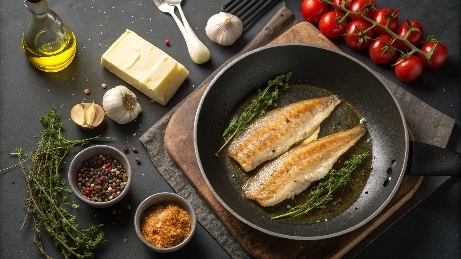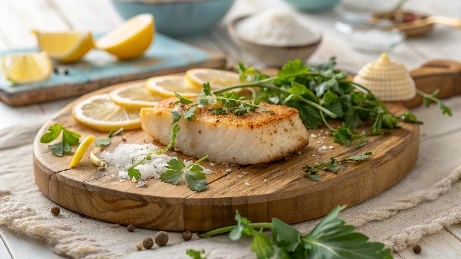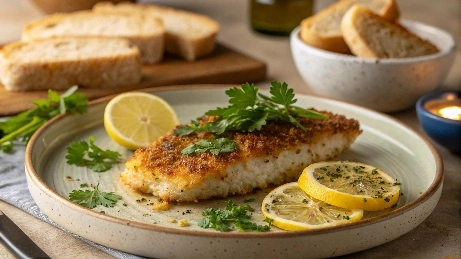If you’re a seafood lover, you’ve probably heard of corbina roe a hidden gem in the world of gourmet fish eggs. While caviar from sturgeon often steals the spotlight, this delicacy deserves just as much attention. With its rich, briny taste and delicate texture, it’s a favorite among chefs and home cooks alike.
In this article, we’ll dive into what makes these fish eggs special, how to prepare them, and why they’re worth trying. We’ll also explore mouthwatering recipes, fishing tips, and cultural influences on this unique ingredient. Whether you’re an experienced angler or an adventurous foodie, this guide has everything you need to know about this Pacific seafood treasure.
Understanding
What Is Corbina Roe?
These edible fish eggs come from the California corbina, a species found along the Pacific coastline, especially in California and Mexico. Known for its mild, white flesh, this fish is highly prized not just for its fillets but also for its flavorful roe.
Unlike larger varieties such as salmon roe or sturgeon caviar, these tiny eggs are more delicate, offering a slightly salty flavor with a creamy texture. When cooked, they develop a soft, velvety consistency, making them a fantastic addition to fried seafood platters, gourmet pasta, and even sushi-inspired dishes.
Where Does It Come From?
Corbina thrive in shallow waters, feeding on crustaceans and other small marine creatures. Surf anglers commonly catch them using sand crabs as bait, particularly during the warmer months between late spring and early fall. Since these fish are not typically farmed, their roe is considered a wild-caught delicacy, available fresh in many seafood markets along the West Coast.
For those who enjoy fishing, catching your own means access to some of the freshest gourmet fish eggs possible!
Nutritional Benefits
Beyond its delicious taste, this ingredient is packed with essential nutrients:
- Omega-3 fatty acids – Supports heart health, brain function, and reduces inflammation.
- Protein-rich – Helps with muscle growth and repair.
- Vitamins & minerals – High in vitamin D, B12, and phosphorus, contributing to strong bones and overall well-being.
With its impressive nutritional profile, this seafood specialty isn’t just a delicacy it’s also a superfood for those seeking heart-healthy dining options.
How to Prepare

Traditional Cooking Methods
There are several ways to prepare this type of roe, but the best method depends on your taste and cooking style. Traditionally, frying, grilling, and sautéing are the most popular techniques, as they enhance its natural flavors while preserving its delicate texture.
- Pan-Fried – Coat in flour or cornmeal, season lightly, and fry in butter or oil for a crispy, golden exterior with a soft, creamy center.
- Grilled – Wrap in foil with olive oil, lemon juice, and herbs, then grill over medium heat for about 10 minutes for a smoky, tender bite.
- Sautéed – Cook gently with garlic, onions, and fresh herbs for a light yet flavorful dish.
These simple techniques highlight the roe’s natural taste while making it easy to incorporate into a variety of meals.
Best Seasonings & Pairings
To enhance its delicate flavor, try pairing it with:
- Citrus – Lemon or lime juice balances the richness.
- Garlic & onions – Adds depth and aroma.
- Fresh herbs – Dill, parsley, and cilantro offer a refreshing touch.
- Spices – Smoked paprika, black pepper, or cayenne can add a subtle kick.
For a balanced meal, serve it with steamed rice, crusty bread, or fresh salads, allowing its briny taste to shine.
Corbina Roe Recipes: Tasty and Easy-to-Make Dishes

Classic Pan-Fried Corbina Roe
This simple recipe lets the natural flavors of corbina roe shine.
Ingredients:
- 1 cup corbina roe
- ½ cup flour or cornmeal
- Salt and pepper to taste
- 2 tbsp butter or olive oil
- Lemon wedges for serving
Instructions:
- Rinse the corbina roe under cold water and pat dry.
- Season with salt and pepper, then coat lightly in flour.
- Heat butter or oil in a pan over medium heat.
- Fry the roe for 3-5 minutes per side until golden brown.
- Serve with lemon wedges.
Spicy Grilled Corbina Roe
Ingredients:
- 1 cup corbina roe
- 2 tbsp olive oil
- 1 tsp smoked paprika
- ½ tsp cayenne pepper
- Salt and pepper to taste
- 1 tbsp chopped parsley
Instructions:
- Preheat the grill to medium heat.
- Toss the corbina roe with olive oil, paprika, cayenne, salt, and pepper.
- Wrap in foil and grill for 10 minutes.
- Garnish with fresh parsley and serve.
Sautéed Corbina Eggs with Fresh Herbs
For a delicate and flavorful dish, try this light sautéed recipe.
Ingredients:
- 1 cup corbina roe
- 1 tbsp olive oil
- 2 cloves garlic, minced
- ¼ cup diced onions
- 1 tbsp fresh dill
- Salt and pepper to taste
Instructions:
- Heat oil in a pan over medium-low heat.
- Sauté garlic and onions until fragrant.
- Add corbina roe and cook for 5 minutes, stirring gently.
- Season with salt, pepper, and fresh dill.
Corbina Roe with Pasta and Garlic Sauce
If you love seafood pasta, this recipe is a must-try!
Ingredients:
- 1 cup corbina roe
- 8 oz spaghetti
- 2 tbsp olive oil
- 3 cloves garlic, minced
- ½ cup cherry tomatoes, halved
- ½ tsp red pepper flakes
- Salt and pepper to taste
- Fresh basil for garnish
Instructions:
- Cook pasta according to package instructions.
- In a pan, heat olive oil and sauté garlic until golden.
- Add cherry tomatoes and cook for 3 minutes.
- Stir in corbina roe and red pepper flakes, cooking for another 5 minutes.
- Toss with pasta, season with salt and pepper, and garnish with basil.
Corbina Roe Sushi and Sashimi Inspirations
can also be enjoyed raw, much like tobiko or masago. It works well as:
- A topping for sushi rolls.
- A garnish for sashimi platters.
- A mix-in for Japanese-style rice bowls.
Simply season it lightly with soy sauce, lemon juice, and wasabi for a delightful umami kick.
Fishing for Corbina: How to Catch Your Own
Best Locations and Seasons for Corbina Fishing
If you want to enjoy corbina roe at its freshest, catching your own corbina is the way to go. These fish are commonly found along the sandy beaches of the Pacific coastline, particularly in Southern California and Baja Mexico. They prefer shallow waters, often just beyond the breaking waves, making them a prime target for surf anglers.
The best time to fish for corbina is late spring through early fall, when they move closer to shore to feed on sand crabs and small crustaceans. Early mornings and late afternoons offer the most success, as corbina are more active in cooler temperatures.
Effective Fishing Techniques for Catching Corbina
Unlike other sport fish, corbina are finicky eaters, which makes them a fun challenge for anglers. Here are some proven techniques to improve your chances of landing one:
- Use the right bait – The best bait for corbina is live sand crabs, which are their natural food source. Other good options include bloodworms, ghost shrimp, and fresh mussels.
- Choose the right tackle – Corbina have excellent eyesight, so using a light fishing setup (6-8 lb test line) with a fluorocarbon leader increases your chances of a bite.
- Fish in the right spots – Look for pockets, troughs, and sandbars, where corbina often search for food. Pay attention to wave patterns to identify prime feeding areas.
- Use a slow, natural presentation – Since corbina are skittish, avoid sudden movements. Let the bait drift naturally with the current for the most realistic presentation.
How to Handle and Store Fresh Corbina Roe
If you’re lucky enough to catch a female corbina carrying roe, proper handling ensures its freshness. Follow these steps:
- Keep the fish cool – Store it on ice immediately to maintain freshness.
- Extract the roe carefully – Once filleting the fish, gently remove the egg sacs without breaking them.
- Rinse lightly – Wash the corbina roe with cold water and pat dry with a paper towel.
- Store properly – For short-term use, keep it in an airtight container in the fridge for up to two days. For longer storage, freeze it in a vacuum-sealed bag for up to three months.
Now that you know how to catch and store corbina roe, let’s explore how different cultures use this delicacy in their cuisine!
Corbina Roe in Global Cuisine
Corbina Roe vs. Other Types of Fish Roe
Many people are familiar with caviar, but how does corbina roe compare to other fish eggs?
- Sturgeon Caviar – The most well-known roe, often eaten raw and salted. Corbina roe is smaller and milder in flavor.
- Salmon Roe (Ikura) – Bright orange and slightly sweet, salmon roe has a firmer texture than corbina roe.
- Tobiko and Masago – Popular in sushi, these tiny eggs (from flying fish and capelin) have a similar size to corbina roe but a crunchier texture.
Unlike some of these more expensive options, corbina roe is a budget-friendly yet delicious alternative that can be used in similar ways.
How Different Cultures Use Corbina Roe in Cooking
Around the world, various cultures have unique ways of preparing fish roe, including corbina roe:
- Japanese Cuisine – Fish roe is commonly used in sushi and rice bowls, often seasoned with soy sauce and wasabi. Corbina roe can be used similarly in homemade sushi.
- Mediterranean Dishes – Countries like Greece and Italy incorporate fish roe into pasta dishes, spreads, and seafood salads. Corbina roe pairs beautifully with olive oil and garlic.
- Mexican and Latin American Cooking – Fried fish roe is a delicacy in some coastal regions, often served with lime and chili for an extra kick.
- Eastern European Cuisine – Fish roe is sometimes salted and spread on bread or blended into dips, much like taramasalata, a Greek fish roe spread.
With its mild, briny taste, corbina roe is a versatile ingredient that works in many cuisines. Whether you prefer it grilled, fried, or mixed into a creamy pasta, there’s no shortage of ways to enjoy this seafood delicacy!
Best Flavor Pairings
To elevate the taste of corbina roe, consider pairing it with:
- Citrusy sauces, like the Lemon Beurre Blanc, which complements the natural brininess.
- Garlic-infused dishes, such as this Garlic Butter Lobster, for an indulgent seafood experience.
- Light and refreshing broths, like this Coconut Lime Fish Soup, which balances out the richness of the roe.
FAQs
Many people have questions about corbina roe and the fish itself. Below, we answer some of the most common ones.
Is corbina a good fish to eat?
Yes! California corbina is highly prized for its mild, white, and flaky flesh. It has a delicate flavor, making it ideal for grilling, frying, or baking. Unlike some fish, corbina has no small bones, making it easy to eat.
Additionally, corbina is a lean protein packed with omega-3 fatty acids, which support heart and brain health. Plus, its roe is considered a delicacy in many cultures!
What kind of fish is a corvina?
Many people confuse corbina with corvina, but they are different species.
- Corbina (Menticirrhus undulatus) – A member of the croaker family, found in shallow coastal waters along the Pacific coast, especially in California and Mexico.
- Corvina (Cilus gilberti) – A larger saltwater fish commonly found in Central and South America, often used in ceviche and grilled dishes.
Although they share similarities, corbina roe is more delicate and subtle compared to corvina roe, which tends to be richer and larger.
What is the difference between a corbina and a croaker?
The California corbina is a species of croaker, but it’s unique because:
- Unlike most croakers, corbina do not have a swim bladder, which means they don’t make the distinctive croaking sound.
- They are bottom feeders, relying on small crustaceans for food.
- They are often harder to catch, requiring more finesse in fishing techniques.
Despite these differences, both corbina and other croakers have delicious meat and roe that are enjoyed in various dishes.
What is the largest corbina ever caught?
According to fishing records, the largest corbina ever caught weighed around 7.5 pounds. These fish typically range from 1 to 3 pounds, so anything over 5 pounds is considered a trophy catch!
Corbina fishing is a favorite among surf anglers, and catching one with a full sack of corbina roe is a special treat for seafood lovers.
How to Enjoy Corbina Roe
There are several ways to incorporate corbina roe into your meals:
- As a topping: Sprinkle it over crispy salmon bites for a burst of umami.
- In pasta dishes: Try it as a garnish on lobster pasta for a gourmet touch.
- With breakfast: Serve it alongside a warm slice of sourdough bagels for a balanced morning meal.
Conclusion: Why You Should Try Corbina Roe
After exploring everything from its origins and preparation to fishing tips and global recipes, one thing is clear corbina roe is a seafood delicacy worth trying.
A Versatile and Nutritious Seafood Option
Whether you fry it, grill it, or add it to pasta, corbina roe offers a unique and delicious experience. It’s:
Mild yet flavorful – Perfect for those new to fish roe.
Rich in nutrients – Packed with omega-3s, protein, and essential vitamins.
Easy to cook – Works well in simple and gourmet recipes.
An Affordable Alternative to Expensive Fish Roe
While caviar and salmon roe can be costly, corbina roe provides a budget-friendly alternative without compromising on flavor or texture. It’s a fantastic way to enjoy the delicacy of fish roe without breaking the bank.
Try It for Yourself!
If you haven’t tried corbina roe yet, now’s the time! Whether you catch your own or find it at a seafood market, give it a shot in one of our easy-to-follow recipes. You might just discover a new favorite seafood dish!
Sustainability and Ethical Considerations
Is Corbina Fishing Sustainable?
With the increasing popularity of corbina roe and the fish itself, it’s important to consider the sustainability of corbina fishing. Fortunately, California corbina is not currently overfished, and it remains a healthy species along the Pacific coast. However, as with any seafood, responsible harvesting is key to ensuring its availability for future generations.
Unlike commercially harvested fish, corbina are primarily caught by surf anglers, which significantly reduces the impact of large-scale overfishing. Additionally, corbina are non-migratory, meaning they stay within a specific region, allowing local fisheries to regulate their populations effectively.
Responsible Fishing Practices
To help maintain sustainable fishing practices, anglers and seafood lovers should follow these guidelines:
- Follow local fishing regulations – Many areas have size and bag limits to prevent overharvesting. Always check your local guidelines before fishing.
- Release small fish and breeders – Letting juvenile corbina and large females carrying corbina roe go back into the ocean helps maintain a healthy population.
- Use ethical fishing methods – Avoid using nets or methods that cause excessive harm to the ecosystem. Light tackle and catch-and-release fishing are encouraged when not keeping fish for consumption.
- Purchase from responsible sources – If buying corbina roe instead of fishing for it yourself, look for wild-caught sources that prioritize sustainable fishing.
By taking these small steps, we can ensure that corbina and its roe remain a delicious and eco-friendly seafood option.
Corbina Roe in Modern Culinary Trends
How Chefs Are Elevating Corbina Roe in Gourmet Dishes
As food trends evolve, chefs and seafood enthusiasts are finding creative ways to incorporate corbina roe into gourmet dishes. While traditionally enjoyed fried or sautéed, modern chefs are using it in elevated, globally inspired recipes.
Some of the latest trends include:
- Corbina Roe Butter – Blending roe with creamy butter to create a rich, umami-packed spread for bread or seafood.
- Corbina Roe Pasta – Adding roe to handmade pasta for a subtle seafood flavor, much like Italian bottarga.
- Fusion Sushi Rolls – Using corbina roe as a topping for sushi, similar to tobiko or masago, for a burst of briny goodness.
- Seafood Tacos – Incorporating lightly grilled corbina roe into fish tacos, paired with fresh citrus slaw and a spicy aioli.
Why Corbina Roe Is Gaining Popularity
More people are turning to affordable seafood options that offer the same luxurious experience as expensive caviar. Corbina roe provides a budget-friendly alternative to salmon roe, tobiko, and caviar, making it a top choice for home cooks and high-end restaurants alike.
Additionally, with the rise of sustainable seafood consumption, diners are looking for eco-friendly choices that don’t contribute to overfishing. Since corbina is locally caught and not farmed, it fits well into the growing demand for responsibly sourced seafood.
As more people discover corbina roe and its versatile culinary uses, expect to see it appearing in everything from gourmet tasting menus to casual seafood platters. If you haven’t tried it yet, now’s the perfect time to get creative in the kitchen!

